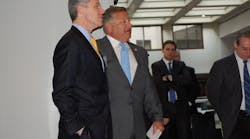WASHINGTON D.C. The time window for getting agreement on how to fund infrastructure needs and especially how to keep the highway trust fund (HTF) solvent is closing rapidly, with members of Congress from both sides of the aisle suggesting several different tactics during speeches at the annual “Washington Briefing” held by the American Association of State Highway Transportation Officials (AASHTO) here in the nation’s capital.
“We need $200 billion just to keep [the HTF] solvent – not increase funding, mind you, but just to keep the status quo. And we all know the status quo not working for us,” noted John Schroer, AASHTO’s current president and commissioner of the Tennessee Department of Transportation.
“In my home state, we had to have the largest tax cut in state history to get a fuel tax increase,” he said. “We did it but the bad news is we wanted $500 million [worth of new fuel taxes] with the fuel tax indexed to inflation. But we ended up getting $248 million and no indexing. Every tax you can think about is indexed on inflation except ours [fuel taxes]. They don’t grow at all.”
Rep. Bill Shuster (R-PA), who is retiring after this term, stressed that the HTF “has to be fixed” because it is estimated to run out of money in October 2020, a month before the next presidential election. “We must deal with this problem, we can’t put our heads in the sand about it,” he told reporters attending the briefing. “Because if October 2020 rolls around and state DOTs start shutting down projects, Republicans will be blamed for it.”
Shuster believes that increasing the fuel tax remains the best way to generate the funds required for roadway and bridge infrastructure needs. “The president called for a 25-cent increase [in fuel taxes per gallon] and in 10 years that gets us $400 billion,” he said. “Looking at all the options out there, this one [fuel taxes] is one understandable to the American people and in Congress. You pay at the pump. It is very difficult to move something [new] in the short time frame we have.”
Shuster added that the 15-cent per gallon fuel tax increased he has proposed would only cost the average American motorists roughly $2 a week in extra costs. “That’s a cup of coffee, or a half a cup if it’s Starbucks,” he said.
He added that “better roads help all of us,” especially in the rural parts of the U.S. “We have long highway miles in Wyoming that are worn down by the big trucks carrying freight from Los Angeles to Chicago; that’s the nation’s commerce,” Barrasso said. “We cannot expect Wyoming to bear that entire burden – that’s why new need a complete national transportation plan.”
Yet on the other side of the aisle, Rep. Peter DeFazio (D-OR) is not convinced those efforts will reap success. “Obviously, there’s a push and pull at the White House over fuel taxes. But the is no sense talking policy if there is no money. And all of the streamlining mandated [in MAP-21 and the FAST Act] has not implemented yet. So while I am willing to look at things, if there is no money for it, there’s no reason to talk.”
At of the end of the day, Carper added, “we should not be too far from each other. Given the need we have and the holes we have on our roads, if we cannot come to a consensus this time, shame on all of us. You need to hold our feet to the fire.”



